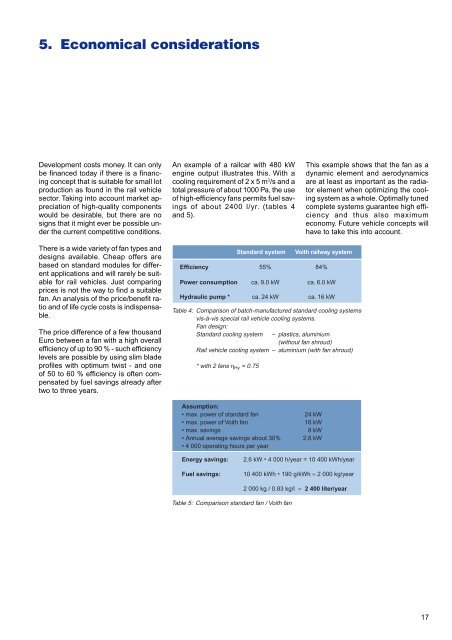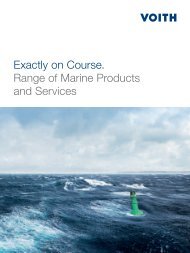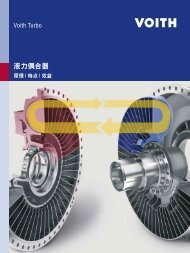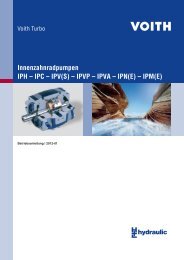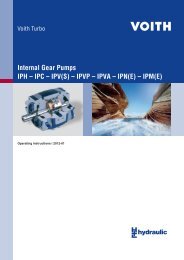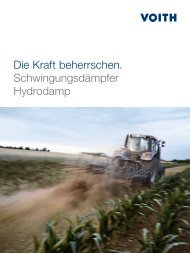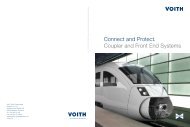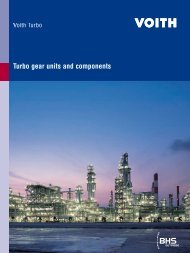Download PDF - Voith Turbo
Download PDF - Voith Turbo
Download PDF - Voith Turbo
Create successful ePaper yourself
Turn your PDF publications into a flip-book with our unique Google optimized e-Paper software.
5. Economical considerations<br />
Development costs money. It can only<br />
be financed today if there is a financing<br />
concept that is suitable for small lot<br />
production as found in the rail vehicle<br />
sector. Taking into account market appreciation<br />
of high-quality components<br />
would be desirable, but there are no<br />
signs that it might ever be possible under<br />
the current competitive conditions.<br />
There is a wide variety of fan types and<br />
designs available. Cheap offers are<br />
based on standard modules for different<br />
applications and will rarely be suitable<br />
for rail vehicles. Just comparing<br />
prices is not the way to find a suitable<br />
fan. An analysis of the price/benefit ratio<br />
and of life cycle costs is indispensable.<br />
The price difference of a few thousand<br />
Euro between a fan with a high overall<br />
efficiency of up to 90 % - such efficiency<br />
levels are possible by using slim blade<br />
profiles with optimum twist - and one<br />
of 50 to 60 % efficiency is often compensated<br />
by fuel savings already after<br />
two to three years.<br />
An example of a railcar with 480 kW<br />
engine output illustrates this. With a<br />
cooling requirement of 2 x 5 m 3 /s and a<br />
total pressure of about 1000 Pa, the use<br />
of high-efficiency fans permits fuel savings<br />
of about 2400 l/yr. (tables 4<br />
and 5).<br />
Standard system<br />
<strong>Voith</strong> railway system<br />
Efficiency 55% 84%<br />
Power consumption ca. 9.0 kW ca. 6.0 kW<br />
Hydraulic pump * ca. 24 kW ca. 16 kW<br />
Table 4: Comparison of batch-manufactured standard cooling systems<br />
vis-à-vis special rail vehicle cooling systems.<br />
Fan design:<br />
Standard cooling system – plastics, aluminium<br />
(without fan shroud)<br />
Rail vehicle cooling system – aluminium (with fan shroud)<br />
* with 2 fans η Hy = 0.75<br />
Assumption:<br />
• max. power of standard fan 24 kW<br />
• max. power of <strong>Voith</strong> fan 16 kW<br />
• max. savings 8 kW<br />
• Annual average savings about 30% 2.6 kW<br />
• 4 000 operating hours per year<br />
Energy savings: 2.6 kW * 4 000 h/year = 10 400 kWh/year<br />
Fuel savings: 10 400 kWh * 190 g/kWh ≈ 2 000 kg/year<br />
Table 5: Comparison standard fan / <strong>Voith</strong> fan<br />
2 000 kg / 0.83 kg/l ≈ 2 400 liter/year<br />
This example shows that the fan as a<br />
dynamic element and aerodynamics<br />
are at least as important as the radiator<br />
element when optimizing the cooling<br />
system as a whole. Optimally tuned<br />
complete systems guarantee high efficiency<br />
and thus also maximum<br />
economy. Future vehicle concepts will<br />
have to take this into account.<br />
17


